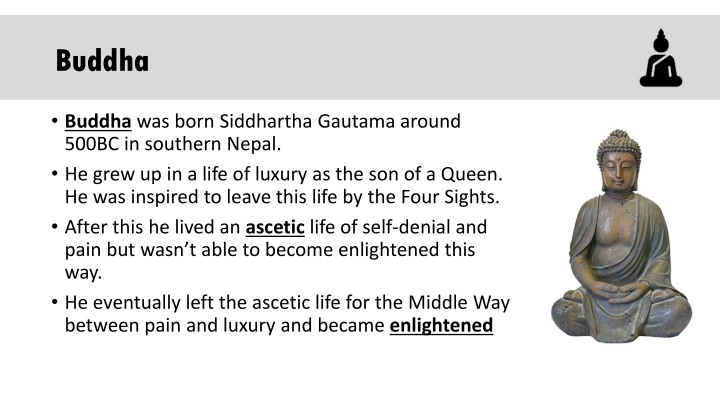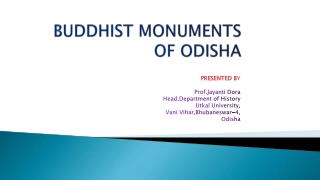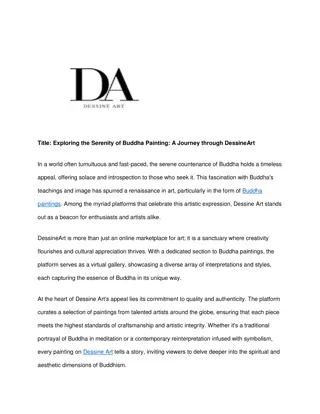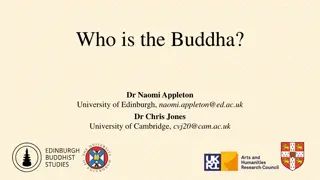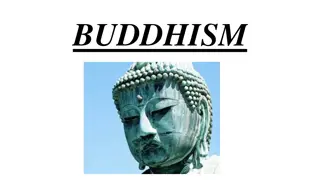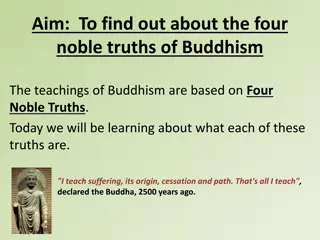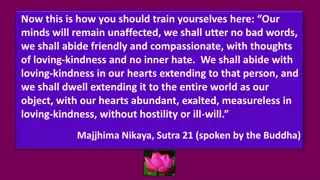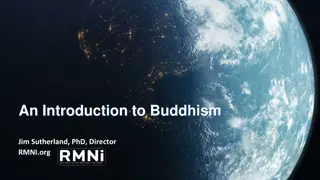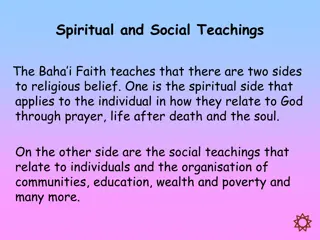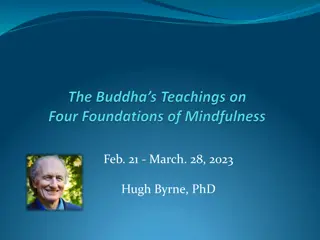The Life and Teachings of Buddha
Buddha, born as Siddhartha Gautama around 500BC in Nepal, left a life of luxury to seek enlightenment after encountering the Four Sights. He eventually found enlightenment through the Middle Way, understanding the Four Noble Truths and following the Eightfold Path. His teachings on suffering, impermanence, and the absence of a fixed soul continue to impact Buddhism.
Download Presentation

Please find below an Image/Link to download the presentation.
The content on the website is provided AS IS for your information and personal use only. It may not be sold, licensed, or shared on other websites without obtaining consent from the author.If you encounter any issues during the download, it is possible that the publisher has removed the file from their server.
You are allowed to download the files provided on this website for personal or commercial use, subject to the condition that they are used lawfully. All files are the property of their respective owners.
The content on the website is provided AS IS for your information and personal use only. It may not be sold, licensed, or shared on other websites without obtaining consent from the author.
E N D
Presentation Transcript
Buddha Buddha was born Siddhartha Gautama around 500BC in southern Nepal. He grew up in a life of luxury as the son of a Queen. He was inspired to leave this life by the Four Sights. After this he lived an ascetic life of self-denial and pain but wasn t able to become enlightened this way. He eventually left the ascetic life for the Middle Way between pain and luxury and became enlightened
The Four Sights The Four Sights Siddhartha saw on his trip outside the palace were: An old man everyone ages An ill man everyone becomes ill A dead man all things die A holy man the only answer to these problems These Four Sights helped him realise that suffering (dukkha) was universal and that it needed to be fixed before enlightenment could be achieved
Enlightenment Enlightenment After the failure of Siddhartha s ascetic life to provide him with enlightenment Siddhartha chose to follow the Middle Way. He meditated under a tree and was tempted by Mara who tried to distract him, but he stayed focused on meditation and reaching enlightenment. Eventually he became enlightened during the Three Watches of the Night where he understood: knowledge of all his previous lives, the cycle of life, death and re-birth (samsara) and that all beings suffer due to desire. After this Siddhartha became enlightened and began to be known as Buddha.
The Three Marks of Existence The Three Marks of Existence The Three Marks of Existence are the fundamental Buddhist beliefs about the nature of human existence. They present a very different view of the world to Christianity. That suffering is inevitable, that everything is impermeant and that we have no fixed, immortal soul. Dukkha Suffering is a part of life that all people must face. Buddhists can try and overcome it. Anicca The idea of impermanence that everything constantly changes and we suffer when we resist it Anatta The idea that we don t have a fixed soul there is no unchanging essence to us
The Four Noble Truths The Four Noble Truths are what Buddha taught about suffering 1. There is suffering >> 2. Suffering has a cause >> 3. Suffering can come to an end >> 4. There is a way to end suffering One of the main causes of suffering is tanha or craving. Other causes are known as the Three Poisons of greed, hatred and ignorance. Ultimately Buddha teaches that we can and must overcome these causes of suffering in order to become enlightened and reach nirvana a state of freedom, happiness and peace
Eightfold Path Eightfold Path The Eightfold Path consists of eight aspects that Buddhists practise and live by in order to be able to overcome suffering and achieve enlightenment e.g. Right speech (speaking truthfully and kindly), right mindfulness (developing awareness of the world around you) and right understanding (developing an understanding of Buddha s teachings)
Types of Buddhism Theravada Known as the lesser vehicle as only male monks achieve enlightenment. Oldest form of Buddhism, found in southern Asia Mahayana Known as the greater vehicle as anyone can become enlightened. Teaches sunyata or emptiness nothing as a separate soul or self Pure Land Mostly found in Japan a form of Mahayana Buddhism. Based on faith in Amitabha Buddha and his paradise.
Bodhisattvas and Bodhisattvas and Arhats Arhats Bodhisattva Mahayana Buddhists aim to become a Bodhisattva. Someone who reaches an enlightened state but chooses to remain in the cycle of samsara to help others reach enlightenment Arhat Theravada Buddhists aim to become an Arhat by following the Eightfold Path. An Arhat is a perfected person who overcomes the main sources of suffering and reaches nirvana
Does the answer have .? 12 Mark Questions A clear three paragraph structure (Disagree, Agree, Conclusion) Disagree / Agree Sentence starters that introduce the opinion e.g. Some Buddhist argue 1. The Three Marks of Existence are the most important Buddhist teaching Two clearly stated opposing views Paragraphs that accurately respond to the question Paragraphs that have a good level of detail and links between statements Reference to religion Reference to religion is accurate Buddhist teaching reference Buddhist reference are accurate and relevant to the question Evaluation of the arguments Evaluation makes sense and matches with the conclusion Conclusion with personal opinion stated Conclusion is well-argued with reference back to religion and evaluation Religion 2. The Four Sights are the most influential part of the Buddha s life Eval Con
